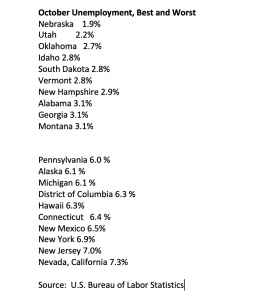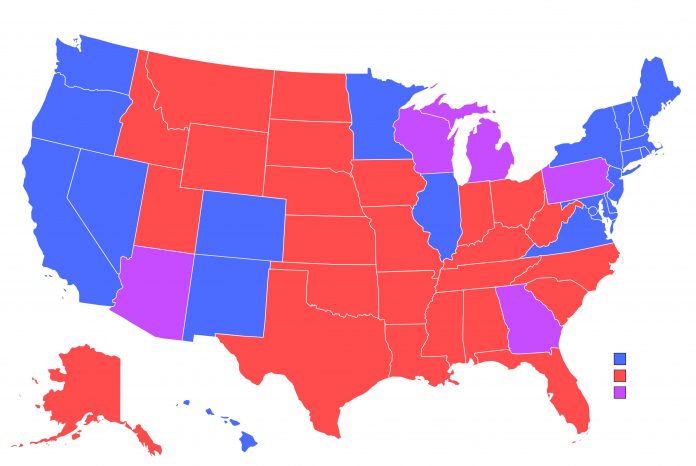Differing local approaches to the Covid-19 pandemic have led to an uneven recovery across the United States, says economist John C. Goodman, president of the Goodman Institute for Public Policy and co-publisher of Health Care News.
“We are in some danger of becoming two Americas,” said Goodman. “One enjoys low unemployment and booming economies. The other has high unemployment and sluggish economic growth. The difference is directly related to public policies.
“Red states, in general, imposed limited lockdowns and were quick to let businesses and schools open back up,” said Goodman. “Blue states, by contrast, imposed harsh lockdowns and other restrictions that were harmful to their economies.”
State Unemployment Gap
States with less restrictive pandemic policies had the lowest unemployment rates, as measured by the U.S. Bureau of Labor Statistics, in October. The Committee to Unleash Prosperity (CTUP), an advocacy group, says the 10 states with the lowest unemployment rates also happen to have Republican governors and Republican-majority legislatures. The exception is Vermont, whose general assembly is controlled by Democrats.
Eight of the 10 states with the highest unemployment rates, including the District of Columbia, are predominantly controlled by Democrats. Michigan and Alaska have Republican legislatures.
“Blue states are economic disaster areas,” writes CTUP. “The unemployment gap between red and blue states has persisted now for nearly two years…and [is] getting worse for places like California, Illinois, New Jersey, and New York.”

Lockdowns v. Jobs
In April, financial information provider WalletHub ranked states by Covid-19 restrictions using 13 metrics based on data from government and private sources.
The 10 least restrictive states, in order of increasing severity, were Iowa, Florida, Wyoming, South Dakota, Texas, Alaska, South Carolina, Mississippi, Oklahoma, and Montana. Of those, four ranked in the top 10 for lowest unemployment in October: Oklahoma (No. 3), South Dakota (No. 4), and Montana (No. 8).
The 10 states with the most restrictive pandemic policies, from most to less severe, were Vermont, Delaware, Virginia, Washington, New York, California, Maine, Connecticut, Rhode Island, and New Jersey. Eight of these states ranked in the lower half of the nation for high unemployment, Vermont, and Virginia excepted.

Policies ‘Lacked a Sound Basis’
Many officials did not consider the economic impact of their edicts, says Brian Blase, president of Paragon Health Institute and former special assistant to the president for economic policy at the White House’s National Economic Council from 2017 to 2019.
“Throughout the pandemic, restrictions imposed by many state and local governments on businesses and schools lacked a sound basis and caused much more harm than benefit,” said Blase. “This harm includes lingering higher rates of unemployment and shuttered businesses.”
Government spending was also a factor, says Blase.
“A main reason that blue states have higher health care costs than red states is that they are much more likely to have profligate Medicaid programs,” said Blase.
Kevin Stone (kevin.s.stone@gmail.com) writes from Arlington, Texas.




















